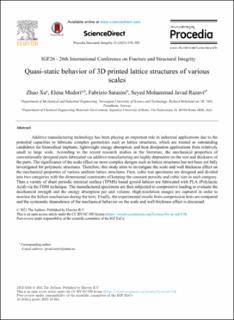| dc.contributor.author | Xu, Zhuo | |
| dc.contributor.author | Medori, Elena | |
| dc.contributor.author | Sarasini, Fabrizio | |
| dc.contributor.author | Razavi, Seyed Mohammad Javad | |
| dc.date.accessioned | 2022-07-07T08:01:36Z | |
| dc.date.available | 2022-07-07T08:01:36Z | |
| dc.date.created | 2021-11-21T15:52:27Z | |
| dc.date.issued | 2021 | |
| dc.identifier.citation | Procedia Structural Integrity. 2021, 33 578-585. | en_US |
| dc.identifier.issn | 2452-3216 | |
| dc.identifier.uri | https://hdl.handle.net/11250/3003381 | |
| dc.description.abstract | Additive manufacturing technology has been playing an important role in industrial applications due to the potential capacities to fabricate complex geometries such as lattice structures, which are treated as outstanding candidates for biomedical implants, lightweight energy absorption, and heat dissipation applications from relatively small to large scale. According to the recent research studies in the literature, the mechanical properties of conventionally designed parts fabricated via additive manufacturing are highly dependent on the size and thickness of the parts. The significance of the scale effect on more complex designs such as lattice structures has not been yet fully investigated for polymeric structures. Therefore, this study aims to investigate the scale and wall thickness effect on the mechanical properties of various uniform lattice structures. First, cubic test specimens are designed and divided into two categories with the dimensional constraints of keeping the constant porosity and cubic size in each category. Then a variety of sheet periodic minimal surface (TPMS) based gyroid lattices are fabricated with PLA (Polylactic Acid) via the FDM technique. The manufactured specimens are then subjected to compressive loading to evaluate the mechanical strength and the energy absorption per unit volume. High-resolution images are captured in order to monitor the failure mechanism during the tests. Finally, the experimental results from compression tests are compared and the systematic dependence of the mechanical behavior on the scale and wall thickness effect is discussed. | en_US |
| dc.language.iso | eng | en_US |
| dc.publisher | Elsevier | en_US |
| dc.rights | Attribution-NonCommercial-NoDerivatives 4.0 Internasjonal | * |
| dc.rights.uri | http://creativecommons.org/licenses/by-nc-nd/4.0/deed.no | * |
| dc.title | Quasi-static behavior of 3D printed lattice structures of various scales | en_US |
| dc.type | Peer reviewed | en_US |
| dc.type | Journal article | en_US |
| dc.description.version | publishedVersion | en_US |
| dc.source.pagenumber | 578-585 | en_US |
| dc.source.volume | 33 | en_US |
| dc.source.journal | Procedia Structural Integrity | en_US |
| dc.identifier.doi | 10.1016/j.prostr.2021.10.064 | |
| dc.identifier.cristin | 1956959 | |
| cristin.ispublished | true | |
| cristin.fulltext | original | |
| cristin.qualitycode | 1 | |

